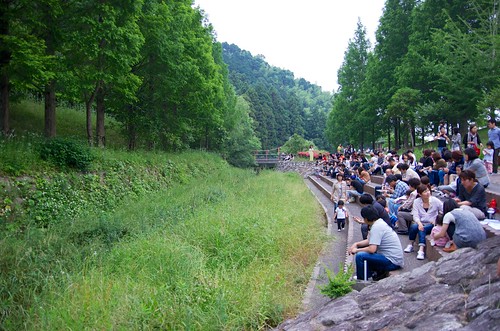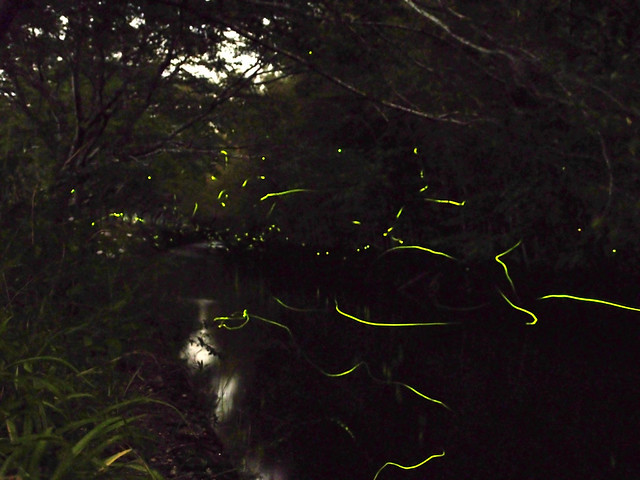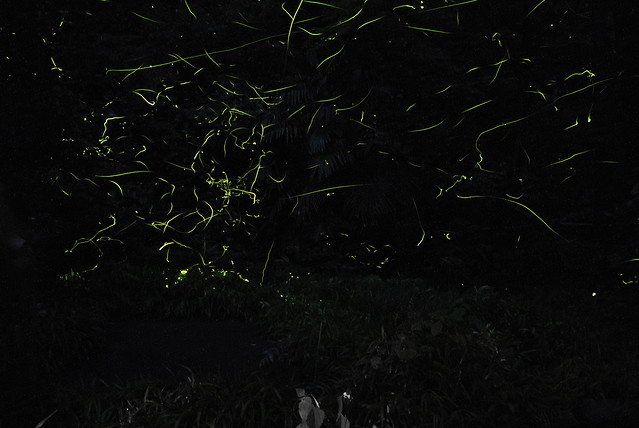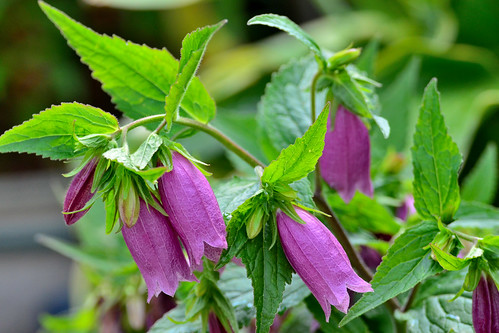Firefly-watching is nearing an end while I am dillydallying. Most of firefly-watching events were done, but some of them will last until mid-July.
 |
| 蛍 / Firefly (credit:St.Také/flickr) |
Kaneda River in Nan-bu cho, Tottori Prefecture
 |
| fireflies 05 (credit: mstkeast/flickr) |
audience waiting to flashing fireflies at Hotaru no Sato in Fukutsu City, Fukuoka Prefecture
 |
| IMGP1346 (credit: yuki5287/flickr) |
mid- to late June
 |
| Numerous fireflies glowed above the stream. 川浦川の蛍(ホタル) (credit: T.Kiya/flickr) |
In early June, Hotaru-hojo-sai (Releasing Fireflies Ritual) is held at Yanagihara Shinchi Pond in Tsurugaoka Hachimangu Shrine, Kanagawa Prefecture. Visitors can see fireflies flashing during a week from the ritual.
 |
| 鶴岡八幡宮ほたるまつり - 柳原神池/鎌倉散歩 (credit: Tranpan23/flickr) |
Tokyo Hotaru Festival imagined fireflies by Sumida river through LED lights. This event is not held any more.
 |
| IMG_9810 (credit: Hetarllen Mumriken/flickr) |
In the Heian period(794-1185), fireflies were referred in literature such as the collection of poems "Collection of Ten Thousand Leaves", Sei Shonagon's "The Pillow Book", Murasaki Shikibu's "The Tale of Genji."
Sei Shonagon praised that lots of fireflies flitted to and fro on a moonless summer night. She also loved that a couple of fireflies hovered and blinked a dim light.
Hotaru (The Fireflies) is the 25th chapter of "The Tale of Genji." When Genji's half-brother Hotaru Hyobukyo no Miya(蛍兵部卿宮) visits Tamakazura(玉鬘, Genji's adopted daughter), Genji releases fireflies behind a screen to light up her with fireflies, showing her beauty to him.
 |
Title: Hotaru (The Fireflies)
Artist: Ichiyosai Toyokuni(Utagawa Toyokuni Ⅲ/Kunisada I , 1786-1864)
Book title: Genjiko no zu(源氏香の図)
courtesy of National Diet Library
|
Genjiko(源氏香) is a game in Ko-do( incense burning) in which participators smell five scents and guess same ones. Five scents can be all the same or different. There are 52 possible combinations of answers. A collection of the patterns that show the combinations is Genjiko no zu. The combinations are assigned to the Chapters of “The Tale of the Genji.” Five vertical lines mean scents. The rightmost line means the first scent, and the leftmost one does the fifth scent. participators connect the lines that seem to be the same scents.
 |
Set partitions 5; Genji symbols
By Watchduck (a.k.a. Tilman Piesk)
from Wikimedia Commons |
 |
| Genjikonozu by Mukai from Wikimedia Commons |
Woman poet Izumi-Shikibu(ca.978-?) depicted fireflies as her visible affection for her husband in one of her waka poems. She felt like her strong feelings for him left her body and flew around flashing. Commuter marriage was common among nobles in the Heian Period. Noblemen visited their wives' houses. It was common that a married couple of nobles lived apart. A nobleman who lost interest in his wife gradually kept away from her. Her husband also had not seen her for a long while.
Minamoto no Shigeyuki (源 重之, died 1000) wrote a poem about one sided love:
"Fireflies can't tell their feelings in words. They can do nothing but burn out. They arouse pity."
In the Edo period, commoners also went out to see fireflies when they began to appear at dusk. Edo residents visited spots to see fireflies such as Sorin-ji Temple in Yanaka, now-defunct Sugatami-bashi Bridge (an area around Nishi-waseda and Takada), an area near Asukayama Park in Kita Ward, an area near Iidabashi, jindai-ji Temple in Chofu City.
 |
Title: Hotaru-gari Azuma Fuzoku(蛍狩当風俗)
(Kabuki actor Sawamura Tanosuke Ⅲ)
Artist: Toyokuni(Utagawa Toyokuni Ⅲ/Kunisada I, 1786-1864)
Publication Date: 1860
courtesy of National Diet Library
|
 |
Title: Hotaru-gari Azuma Fuzoku(蛍狩当風俗)
(Kabuki actor Ichikawa Ichizo Ⅲ)
Artist: Toyokuni(Utagawa Toyokuni Ⅲ/Kunisada I, 1786-1864)
Publication Date: 1860
courtesy of National Diet Library
|
 |
Title: Hotaru-gari Azuma Fuzoku(蛍狩当風俗)
(Kabuki actor )
Artist: Toyokuni(Utagawa Toyokuni Ⅲ/Kunisada I, 1786-1864)
Publication Date: 1860
courtesy of National Diet Library
|
 |
Title: Hotaru-gari Azuma Fuzoku(蛍狩当風俗)
(Kabuki actor )
Artist: Toyokuni(Utagawa Toyokuni Ⅲ/Kunisada I, 1786-1864)
Publication Date: 1860
courtesy of National Diet Library
|
 |
| Title: Odori Keiyo Gedaizukushi(踊形容外題尽) Eiri shosetsu asagao monogatari(絵入稗史蕣物語) Artist: Utagawa Toyokuni III(Utagawa Kunisada I, 1786-1864) Publication Date: 1856 courtesy of National Diet Library |
hotarukago:
https://blog.tokyu-resort.co.jp/branch/nasu/200907/29/blog091636-17227.html
An around 70-year-old woman who were born and raised in Tokyo, one of my friends, saw fireflies flickering above the paddies in her childhood. They used to be common insects even in Tokyo until about 60 years ago. Now fireflies drastically have decreased in Japan because they can live only in clean rivers. So artificially-raised fireflies are released in many parts of Japan. Even now, there is a natural growth area of fireflies in Seijo, Tokyo. The area is not open to the public for the sake of environmental preservation.
 |
| ホタルブクロ/蛍袋 (Bellflower) (credit: Dakiny/flickr) |
 |
| Hotaruyaki (credit: raichovak/flickr) porcelain with a transparent pattern called 'hotarude' |


